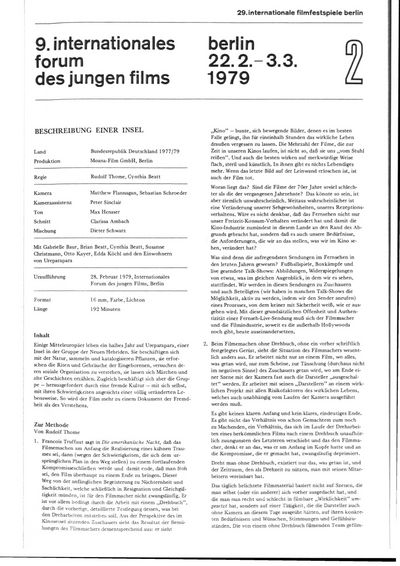4. Documentary fiction depicts something that is really happening. As there is no script to tell them what to say and do, its actors must therefore invent what they say and do at the moment of filming, just like real people do in everyday life. As everyday life cannot be depicted in its entirety, certain sections of it must be defined, much like in a documentary. These sections form the framework that the actors must then follow. But they are otherwise not subject to any restrictions. I’ve made two films in such a way: MADE IN GERMANY UND USA (1974) and TAGEBUCH (1976).
My principle when making these two films was to bring as little fiction as possible into what I was filming. When making documentary fiction that draws on improvisation, fiction becomes a form of medicine only administered to the patients, that is, the actors, when a serious illness has been diagnosed, when the progression of the story seems to have come to a standstill. I don’t mean story literally here, as no story is being told in the conventional sense anyway. For the concept of a story means that whatever is being told is already in the past and has already been set out in advance.
5. When shooting this sort of improvised documentary fiction, sections of reality form themselves into different “arrays” whose “points of intersection” are not fixed, with their meaning remaining open or, even better, in flux. These arrays are created based both on free association and several people working together and develop into an ever more complicated system of references in the mind of the filmmaker and his or her team with each shooting day that passes (a system not clearly apparent to those not involved in the process of creating it). Getting your bearings within this system and progressively condensing it, much like how a spider weaves its web ever more finely and tightly, generates an enthusiasm in all those involved that only grows in intensity. It is exactly the opposite situation to that described by Truffaut.
The fact that it remains open during the entire shoot, until the final day of shooting in fact, whether a scene will be created on any given day that will throw the meaning of everything previously shot into disarray and cast all that has thus far occurred, been developed and experienced in a new light, is a challenge to the imagination of everyone involved in the process.
As such scenes arise several times during the shoot, anyone working on the film that is not prepared for such things can easily feel a bit unsteady on their feet and lose any sense of orientation for a while. The only fixed point of reference they can cling to is the end of the agreed period of shooting. This makes the length of the working period set out in advance and the quantity of film negative available hugely important for this type of filming.
6. Improvised documentary fiction gives filmmaking and those who work in it the same freedoms that those active in the other arts have always made use of. The “free activity of fancy”, writes Hegel, is the “source of all art works”. Filmmaking of this kind is no longer just concerned with translating a film invented in either the filmmakers’ head or someone else’s into sounds and images, with “implementing” the process. The filmmaker is no longer an “implementer” but rather creates something where there was nothing before.
And the product spontaneously created in such fashion can perhaps also reflect the spark of enthusiasm that led to its creation, with perhaps this type of film being the one to succeed once again in passing this spark on to audiences.
A filmmaker that uses this method does not work according to a finished, self-contained model (as represented by a script), but rather sets a process in motion whose essence it is to search for what is supposed to be made, whereby the model and the form (the art work) coincide, whereby what to be expressed and its expression, form and content become one.
7. This form of filmmaking proceeds in a way analogous to science, as the filmmaker equally wants to find out something previously unknown. This type of filming is an adventure, a research trip into unchartered territory (needless to say, it makes no difference here where the film is shot). The filmmaker wants to find out how people behave and to portray this accordingly. If you apply the concept of “ethnography” not just to foreign, “primitive” peoples, but to one’s own people too, I’ve basically already made such ethnographical features in the form of MADE IN GERMANY UND USA and TAGEBUCH. It thus seems only logical that I attempt to continue along the same path following these films by making this method of ethnographical filmmaking the subject of my new film.
And while for those two films, I still had the choice of shooting them with or without a script (as I was familiar with the people and how they live), I have no other choice for the film I’m currently planning, as I neither know the inhabitants of Ureparapara nor how the Europeans will behave when confronted with such a foreign world. Everything I might be able to invent there would be lies and charlatanism.
Filmkritik No. 245, May 1977, pp. 226 - 229
